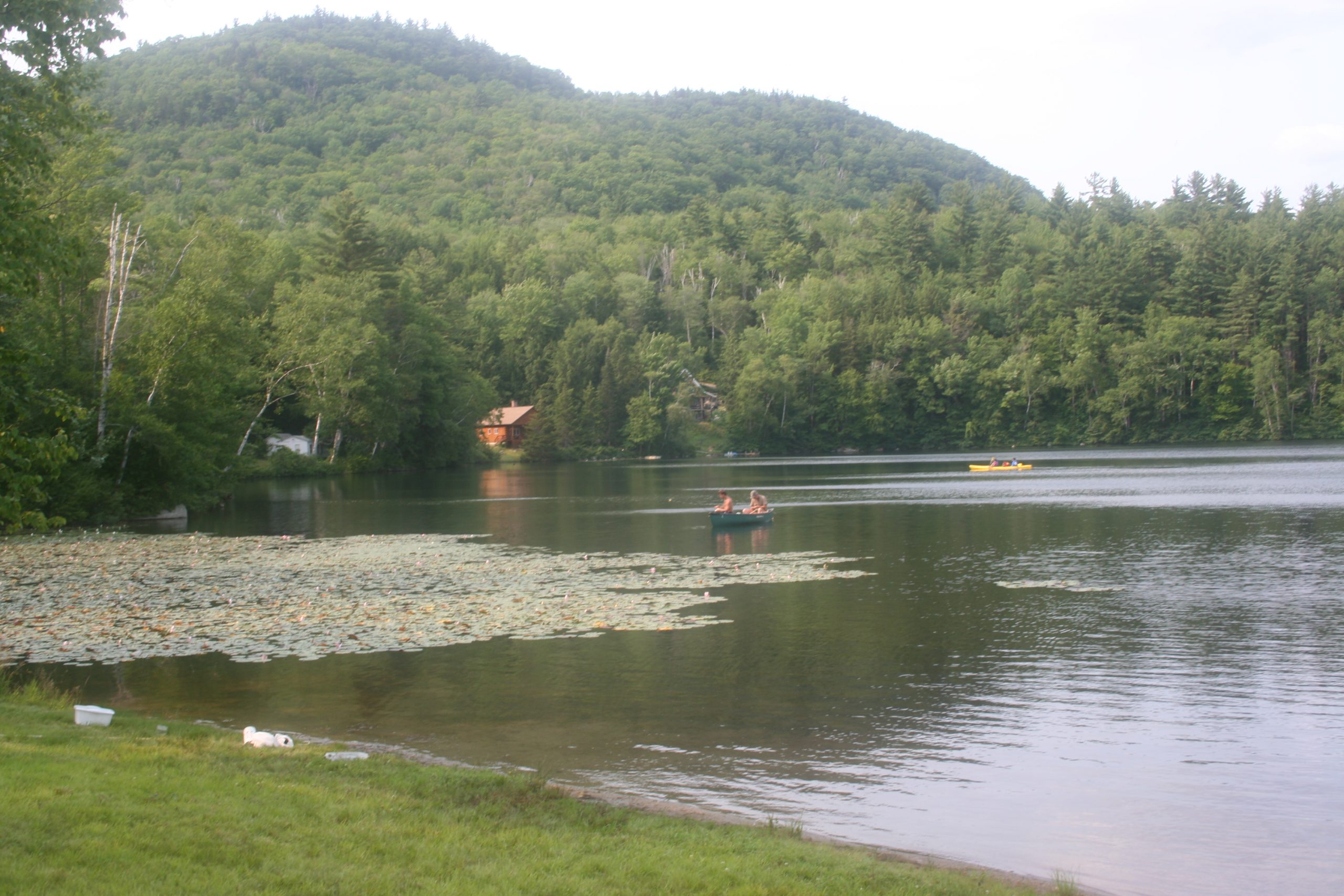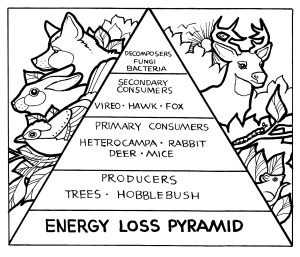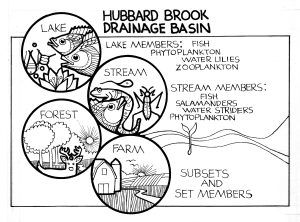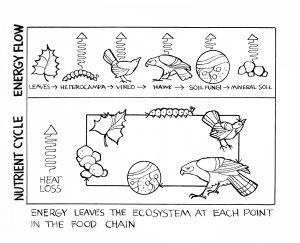Dave M., a biology student, did a lot of his fieldwork during the early evening and morning when the fish were biting. He caught 90 percent of his specimens by angling – fishing, fishing, fishing! Two net and six cylindrical wire mesh traps worked for him during the day. He checked these regularly for the small fish.
Midday often found his eye glued to a microscope in the lab next to Penny. He sorted the contents of fish stomachs for clues to fish diets.
One day, Dave took a pickerel from a large bottle filled with formaldehyde, a preserving fluid. He picked up his surgical scissors and expertly snipped the belly of the fish – the medial ventral line, he called it. He laid to each side the flaps of the belly and removed the stomach. Carefully he tied the stomach ends with string to keep the contents from spilling. The stomach was labeled and preserved in a second bottle. During the winter Dave examined stomach contents under a microscope in his college lab.

At Hubbard Brook he worked on one stomach to get a preview of what the food chain in the lake might be. Hard, chitinous (shell-like) parts of a small crayfish were visibly outlined through the milky-colored stomach sac. He opened the gullet with his long tweezers. The scales and bones inside were clues to the food of this one fish.
Some of Dave’s lake fish at sometime in their small youth had eaten zooplankton like those that busied Joe, who was counting in the dining room. One of his fish, a smallmouth bass, ate abundant terrestrial items like the Heterocampa caterpillar Dot was studying.
Dave became interested in watching fish when he was a very young boy in grade school. At home in his basement he had tank after tank of fish. He just never outgrew his early hobby. And he really did like to fish!
Everyone told Dave that it must be nice to be paid for fishing. But Dave discovered when you have to fish, even fishing can become work at times. On the whole, he believed himself happier doing something he liked in the outdoors. No one can expect 100 percent contentment, and neither did Dave.
The U.S. Fish and Wildlife Service had been Dave’s employer when he had worked summers as an assistant for the survey crew of a fish commission. Now his interest in ichthyology – the study of fish – had put him on the path to becoming an ichthyologist and a science teacher.
Dave was a quiet person, not given to loud outbursts or long discussions. He was a peaceful person with a strong sense of justice and didn’t argue for the sake of argument. He knew the goals for his project and was able to state them clearly and briefly.
First he hoped to find out which species of fish lived in the lake and their approximate numbers. Second, he wanted to determine the most important food for each species. And third, he wanted to see how important a fish was to the life of its predator and how much it fed on other species of fish. For instance, maybe the pickerel ate only crayfish. This fact would make the pickerel a big predator of the crayfish. If it was a big predator and you removed all the pickerel, you might hypothesize or deduce that an increase in the numbers of crayfish would occur. This might be bad or good for the lake, depending upon what you valued or wanted for the lake. If a fish was only an occasional predator of the crayfish, you could hypothesize that there wouldn’t be too much change in the crayfish population. So what and how much an animal eats is important in figuring out the future of a given lake or place. Scientists must know what is happening to a lake before they can determine what may happen if they do something different to the lake ecosystem.
After Dave learned what happened in the daily life and seasonal life of the fish, he wanted to investigate the “energetics” of the food chains and food webs in the lake. Since fish are thought of as mobile, changing accumulations of energy and nutrients, Dave wanted to discover how many food calories crustaceans, like crayfish and Joe’s zooplankton, and the smaller fish consumed. He also wanted to know how much energy these same fish, the crustaceans and smaller fish, provided for their predators.
Energetic studies of the lake and forest ecosystems were concerned with potential food energy. Food energy was measured by a unit called a calorie – the same kind of calorie dieters count.
A calorie is the amount of heat needed to raise the temperature of 1 gram of water 1 degree centigrade. Four thousand calories is equivalent to about one pound of fat. Energy is transferred from one organism to another by way of their nutrient and consumer relation, or “who eats whom.”
The principle that energy is not made or lost, only changed, may be true. But in an ecosystem, energy can be lost for use in that ecosystem by changing into heat and escaping into the air. When the earth is considered as a single ecosystem, energy can be lost to the atmosphere and space, although some heat may accumulate in space and affect earth.
Energy is lost at each link in a food chain. Some energy is not passed on to the next consumer. A pyramid is often used to show ecosystem energy loss.

The number of calories in grass eaten by a cow is more than the number of calories a person receives in eating a cow that ate the grass. Mankind gets more of the sun’s energy, or calories, by eating the same weight of plants than by eating animals. A primary consumer receives more calories from a measured amount of grain than a secondary consumer that eats meat made from that same amount of grain.
The story about the cat that ate the mouse that ate the malt that lived in the house that Jack built is a food chain story. Energy is lost between each step in a food chain. Energy was lost when the malt was eaten by the mouse and when the mouse was eaten by the cat.
“Lost” energy was energy used by the organism, plant, or animal, to move, make body repairs, grow, reproduce, and in mammals, to maintain body temperature. To be active, doing all the things organisms do, takes energy. You become aware that body heat is lost in space when you put on a coat or cover yourself with a blanket or sleeping bag. You trap your own escaping heat, or energy, and it warms you. A blanket doesn’t bring heat with it, unless, of course, it’s an electric blanket.
Nutrients can cycle from one form of life to another, changing their form according to the individual organism’s genetic blueprint. Eventually decomposers break up and decay dead organisms. The chemicals of the organisms return to the soil, water, or air as raw materials. Then the chemical building blocks of each organism – the carbon, oxygen, hydrogen, nitrogen, calcium, phosphorous, and other elements – are ready to recycle. These chemicals in their solid, liquid, or gaseous forms are part of a system. Even the minerals and gases not used as parts of living organisms are still parts of the ecosystem. Ecosystems contain all the nonliving as well as living parts of an environment.
While nutrients can cycle in an ecosystem, the energy from the sun cannot cycle. The sun’s energy is used and then gone. Such energy is on a one-way street. It cannot cycle back to where it started. The calories Tink and Patsy measured when they burned their twigs showed how much potential energy existed in the wood. But after the wood was burned – using the energy and providing the measurement – that energy could no longer be used in Earth’s ecosystem.
You can sketch a diagram on notebook paper showing nutrient cycling with a circle of arrows. Now show energy flow with a straight line of arrows, ending in “heat.” Between each arrow on the straight line some heat is lost. Put a zigzag line between each pair of arrows to show this heat loss. Now you can picture for yourself the difference between nutrient cycling and energy flow.
What were the boundaries of Dave’s ecosystem study? Where did his ecosystem start and stop?
Like cities, towns, counties, boroughs, megalopolises and suburbs that go all over the countryside, like Los Angeles County, ecosystems come in all sizes from very tiny or microscopic to the whole earth. The word “system,” the way ecologists use it, means a set of things so related or connected as to make a whole. Size just depends on what the ecologist is talking about. Ecologists’ systems work. And to work, energy is needed. So every ecosystem has an energy source for its living members, or components. Dave’s ecosystem was the lake. Its boundaries were the interface between water and air, and the interface between water and shoreline.
Ecosystems are open systems. Things come into the lake. Inputs include sunlight, rain, sand, insects, rivers, soap, and so forth. Things go out of the lake. Outputs include water, fish, salamanders, chemicals, and such. But everything in the system affects the whole system in some way. If the something is living, the organism is part of a community and acts as a link in the ecological chain.
Let’s try to synthesize, or put together, our ecosystem information by using the set theory of mathematics. Let a lake, stream, or meadow be an ecosystem, or set. Each ecosystem has many members. Some of the members, or set members, are producers – plants able to trap energy from the sun (energy source for the ecosystem and a set member). The experimental forest, Mirror Lake, Hubbard Brook, or Pleasant View could each be considered separate ecosystems, or sets. And each of these systems, or sets, can be thought of as a subset of the west side of Hubbard Brook drainage basin, the larger ecosystem, or set. Each drainage basin, including the Hubbard Brook basin, can be considered a subset of the White Mountain range ecosystem.
Next time you eat your lunch, think about ecosystems. You are an ecosystem member, but not a complete ecosystem. You don’t have your own energy source. You may have a lot of systems functioning to keep you alive, but an ecosystem you are not. You are dependent on a much larger ecosystem – one that includes the farmer’s peanuts, grain, cows, and grass, plus all the people and transportation in between that put a peanut butter sandwich and a glass of milk into your hands.
By the end of Dave’s Mirror Lake ecosystem study, he had marked and returned 166 fish to the lake and recaptured 39 of them. He had analyzed 132 fish stomachs.

He found five different kinds of fish. He discovered that the diets of the young fish were not the same as the diets of older fish. And he concluded that food might be limiting the growth of the smallmouth bass and the chain pickerel, since the normal adult food items were rare or absent.
Dave found that four elements explained the differences in fish diets: (1) what was available; (2) where the food was in the lake; (3) the size of the predator and its prey – a fish tends to eat something smaller than itself; (4) where the fish had learned to look for food. Fish learned to look for food in certain places. Bass waiting near the surface would be quick to snatch an “input” Heterocampa dropping from a tree or flying bird. Perch, which searched elsewhere, would take longer to find an “input” insect.
Dave typed up his findings, passed his oral exam about his thesis, and sent out his job applications. Wherever his job is now, Dave can probably be found with a fishing pole in his hand – fishing, fishing, fishing.

